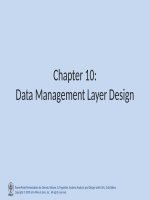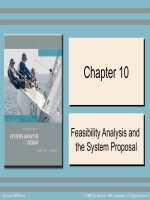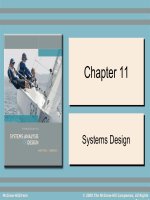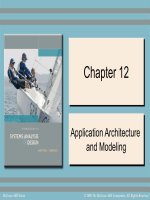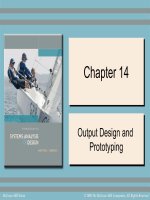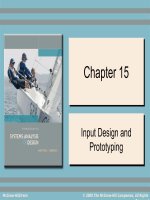Lecture Introduction to systems analysis and design Chapter 10 Whitten, Bentley
Bạn đang xem bản rút gọn của tài liệu. Xem và tải ngay bản đầy đủ của tài liệu tại đây (677.43 KB, 39 trang )
Chapter
Chapter 10
10
Feasibility
Feasibility Analysis
Analysis and
and
the
the System
System Proposal
Proposal
McGraw-Hill/Irwin
© 2008 The McGraw-Hill Companies, All Rights Reserved
10-2
Objectives
• Identify feasibility checkpoints in the systems
life cycle.
• Identify alternative system solutions.
• Define and describe four types of feasibility and
their respective criteria.
• Perform various cost-benefit analyses using
time-adjusted costs and benefits.
• Write suitable system proposal reports for
different audiences.
• Plan for a formal presentation to system
owners and users.
10-3
Feasibility Analysis
Feasibility – the measure of how beneficial or
practical an information system will be to an
organization.
Feasibility analysis – the process by which
feasibility is measured.
Creeping Commitment – an approach to
feasibility that proposes that feasibility should be
measured throughout the life cycle.
10-4
Feasibility Checkpoints During
Systems Analysis
10-5
Four Tests For Feasibility
Operational feasibility – a measure of how well a
solution meets the system requirements.
Technical feasibility – a measure of the practicality of a
technical solution and the availability of technical
resources and expertise.
Schedule feasibility – a measure of how reasonable the
project timetable is.
Economic feasibility - a measure of the costeffectiveness of a project or solution.
10-6
Operational Feasibility
• How well proposed system solves the
problems and takes advantage of
opportunities identified during the scope
definition and problem analysis phases
• How well proposed system satisfies
system requirements identified in the
requirements analysis phase
• Is the problem still worth solving?
10-7
Technical feasibility
• Is the proposed technology or solution
practical?
• Do we currently possess the necessary
technology?
• Do we possess the necessary technical
expertise?
10-8
Schedule feasibility
• Are specified deadlines mandatory or
desirable?
• Are mandatory deadlines realistic for
proposed solution?
10-9
Economic feasibility
• During Scope Definition
– Do the problems or opportunities warrant the cost of
a detailed study and analysis of the current system?
• During Problem Analysis
– After a detailed study of the current system
– Better estimates of development costs and benefits
• During Decision Analysis
– Requirements now defined
– Development costs can be better estimated
10-10
Information System Costs
• Development costs - one time costs that will
not recur after the project has been completed.
–
–
–
–
–
Personnel
Computer usage
Training
Supply, duplication, and equipment
Computer equipment and software
• Operating costs - costs that recur throughout
the lifetime of the system.
– Fixed costs — occur at regular intervals but at
relatively fixed rates.
– Variable costs — occur in proportion to usage.
10-11
Information System Benefits
• Tangible benefits are those that can be easily
quantified.
• Intangible benefits are those benefits believed
to be difficult or impossible to quantify.
– Fewer processing errors
– Increased throughput
– Decreased response time
– Elimination of job steps
– Increased sales
– Reduced credit losses
– Reduced expenses
10-12
Costs for a Proposed Solution
10-13
Three Popular Techniques to
Assess Economic Feasibility
• Payback Analysis
• Return On Investment
• Net Present Value
10-14
Time Value of Money
• Used with all three cost-effectiveness
techniques.
• Concept that recognizes that a dollar today is
worth more than a dollar one year from now.
– Invest $100 at 2% for one year yields $102.
– So $100 today and $102 one year from today
represent the same value.
– Given $20,000 benefit from information system two
years from now and 10% return from other
investments, means that benefit is worth $16,528
today.
10-15
Payback Analysis
Payback analysis – a technique for
determining if and when an investment will
pay for itself.
Payback period – the period of time that
will lapse before accrued benefits
overtake accrued and continuing costs.
10-16
Present Value Formula
Present value – the current value of a
dollar at any time in the future.
PVn = 1/(1 + i)n
Where n is the number of years and i is discount rate
Discount rate – a percentage similar to interest
rates that you earn on your savings.
– In most cases the discount rate for a business is
the opportunity cost of being able to invest money
in other projects or investments
10-17
Payback Analysis for a Project
10-18
Return-on-Investment Analysis
(ROI)
Return-on-Investment (ROI) analysis – a
technique that compares the lifetime profitability
of alternative solutions.
The ROI for a solution or project is a percentage rate that
measures the relationship between the amount the business
gets back from an investment and the amount invested.
Lifetime ROI =
(estimated lifetime benefits – estimated lifetime costs) /
estimated lifetime costs
Annual ROI = lifetime ROI / lifetime of the system
10-19
Net Present Value (NPV)
Analysis
Net present value – analysis technique that compares
annual discounted costs and benefits of alternative
solutions.
10-20
Candidate Systems Matrix
Candidate 1 Name
Candidate 2 Name
Candidate 3 Name
Stakeholders
Knowledge
Processes
Communications
Candidate Systems Matrix – a tool used to document
similarities and differences between candidate systems.
– Stakeholders - how system will interact with people and other
systems.
– Knowledge - how data will be implemented, how inputs will be
captured, how outputs will be generated.
– Processes - how processes will be built and implemented.
– Communications - how processes and data will be
distributed.
Sample Candidate Systems
Matrix
Characteristics
Portion of System
Computerized
Brief description of that portion
of the system that would be
computerized in this
candidate.
Benefits
Brief description of the
business benefits that would
be realized for this candidate.
Servers and
Workstations
A description of the servers
and workstations needed to
support this candidate.
Software Tools Needed
Software tools needed to
design and build the candidate
(e.g., database management
system, emulators, operating
systems, languages, etc.). Not
generally applicable if
10-21 applications software
packages are to be purchased.
Candidate 1
Candidate 2
Candidate 3
COTS package Platinum
Plus from Entertainment
Software Solutions would be
purchased and customized
to satisfy Member Services
required functionality.
Member Services and
warehouse operations in
relation to order fulfillment.
Same as candidate 2.
This solution can be
implemented quickly
because it’s a purchased
solution.
Fully supports user required
business processes for
SoundStage Inc. Plus more
efficient interaction with
member accounts.
Same as candidate 2.
Technically architecture
dictates Pentium III, MS
Windows 2000 class servers
and workstations (clients).
Same as candidate 1.
Same as candidate 1.
MS Visual C++ and MS
Access for customization of
package to provide report
writing and integration.
MS Visual Basic 5.0
System Architect 2001
Internet Explorer
MS Visual Basic 5.0
System Architect 2001
Internet Explorer
10-22
Sample Candidate Systems
Matrix (cont.)
Characteristics
Application Software
Candidate 1
Candidate 2
Candidate 3
Package solution
Custom Solution
Same as candidate 2.
Client/Server
Same as candidate 1.
Same as candidate 1.
(2) HP4MV department laser
printers.
(2) HP5SI LAN laser printers
(1) PRINTRONIX bar-code printer
(includes software & drivers)
Same as candidate 2.
A description of the software
to be purchased, built,
accessed, or some
combination of these
techniques.
Method of Data
Processing
Generally some combination
of: on-line, batch, deferred
batch, remote batch, and realtime.
Output Devices and
Implications
(2) HP4MV
department laser
A description of output devices printers
that would be used, special
(2) HP5SI LAN laser
output requirements, (e.g.,
printers
network, preprinted forms,
etc.), and output
considerations (e.g., timing
constratints)
Web pages must be designed to
VGA resolution. All internal
screens will be designed for SVGA
resolution.
10-23
Sample Candidate Systems
Matrix (cont.)
Characteristics
Input devices and
Implications
Candidate 1
Candidate 2
Candidate 3
Keyboard & mouse.
Apple “Quick Take” digital camera
and software
(15) PSC Quickscan laser barcode scanners
(1) HP Scanjet 4C Flatbed
Scanner
Keyboard and mouse
Same as candidate 2.
MS SQL Server
DBMS with 1000GB
arrayed capability.
Same as candidate 1.
Same as candidate 1.
A description of input methods
to be used, input devices (e.g.,
keyboard, mouse, etc.),
special input requirements
(e.g., new or revised forms
from which data would be
input), and input
considerations (e.g., timing of
actual inputs).
Storage Devices and
Implications
Brief description of what data
would be stored, what data
would be accessed from
existing stores, what storage
media would be used, how
much storage capacity would
be needed, and how data
would be organized.
Feasibility Analysis Matrix
Feasibility Analysis Matrix – a tool
used to rank candidate systems.
Weighting
Description
Operational Feasibility
Technical Feasibility
Schedule Feasibility
Economic Feasibility
Ranking
10-24
Candidate 1
Candidate 2
Candidate 3
10-25
Sample Feasibility Analysis
Matrix
Wt
Candidate 1
Purchase commercial
off-the-shelf package for
member services.
Candidate 2
Write new application inhouse using new company
standard VB.NET and SQL
Server database
Candidate 3
Rewrite current in-house
application using
Powerbuilder.
15%
Supports only Member
Services requirements.
Current business
process would have to
be modified to take
advantage of software
functionality. Also there
is concern about security
in the system.
Fully supports userrequired functionality.
Fully supports userrequired functionality.
Description
Operational
feasibility
Score: 60
Score: 100
Score: 100
